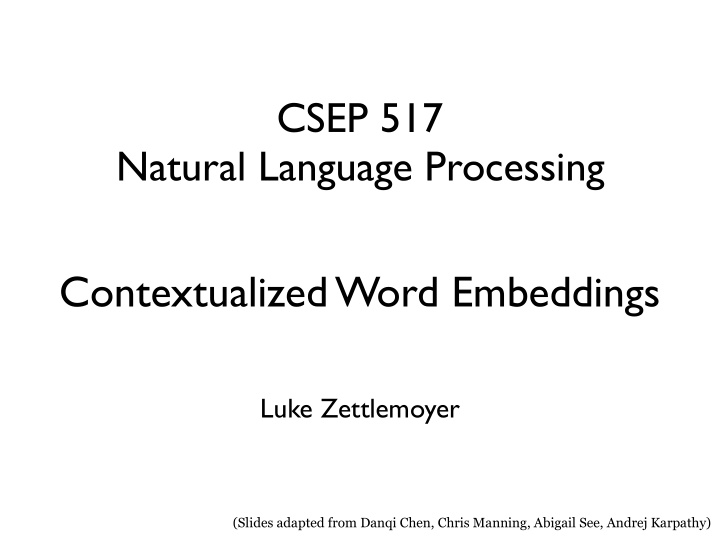



CSEP 517 Natural Language Processing Contextualized Word Embeddings Luke Zettlemoyer (Slides adapted from Danqi Chen, Chris Manning, Abigail See, Andrej Karpathy)
Overview Contextualized Word Representations • ELMo = E mbeddings from L anguage Mo dels • BERT = B idirectional E ncoder R epresentations from T ransformers
Recap: Transformer • Transformers
Recap: word2vec word = “sweden”
<latexit sha1_base64="ZS1t+SATcIQYaJ4VZuEjXjz0Y=">ACOXicbZDPShxBEMZrjIk65s8aj3poIoFcsvRsQlSIHjxuIKrws6y9PTWro09PUN3jbgM8wx5m1zyFt4ELx4U8ZoXSM+uiFE/aPj4VRVd9SW5Vo4vwhmXs2+fjM3vxAuvn3/kNj6eOByworsSMzndmjRDjUymCHFGk8yi2KNF4mJzs1PXDU7ROZWafxjn2UjEyaqikI/6jfZpv4wJz6j0pKq2wjBkTJlngqy6qwKv/Jmq/WdxXHIm9E3XpsabfIpaq3/CGM0g4eBfmON/lE7LmJ7s3a9uqvmAFAu984jweZLFI0JLVwrhvxnHqlsKSkxiqMC4e5kCdihF1vjUjR9crJ5RX7MmADTPrnyE2oY8nSpE6N04T3+n3O3ZPazV8qdYtaLjRK5XJC0Ijpx8NC80oY3WMbKAsStJjb4S0yu/K5LGwQpIPO/QhRE9Pfm4OWs3Ih7rn0/gJU83DCnyCLxDBOmzDLrShAxJ+wyVcw03wJ7gKboO7aetMcD+zDP8p+PsPf3eqbQ=</latexit> <latexit sha1_base64="X7JObiHYNXwbsISLOmkjXbSsJws=">ACOXicbZBNSyNBEIZ7/Fh1dHejHvXQrCx42dCTFT9AQfDiMYJRIRNCT6cSG3t6hu4aMQzG/w3Xrz5E7wJXjwo4lW825OIrLovNLw8VUVXvVGqpEXGbryR0bHxbxOTU/70zPcfPyuzcwc2yYyAhkhUYo4ibkFJDQ2UqOAoNcDjSMFhdLJT1g9PwViZ6H3sp9CKeU/LrhQcHWpX6qftPEQ4w9yRotjywh6UudpzNHIs8L/w6q12goNQ59Vg7+sNCXaYENUW1v1Q9Cd94F2ZYlV2UD0qwnezNL24nm4/HJ1Xm9XrsNOIrIYNArFrW0GLMVWzg1KoaDw8xCysUJ70HTWc1jsK18cHlBfzvSod3EuKeRDui/EzmPre3Hket0+x3bz7US/q/WzLC73sqlTjMELYfdTNFMaFljLQjDQhUfWe4MNLtSsUxN1ygC9t3IQSfT/5qDmrVwIW659LYJENkgXyiyTgKyRbJL6qRBLkgt+SePHiX3p36D0NW0e8t5l58kHe8yuUTqy7</latexit> <latexit sha1_base64="X7JObiHYNXwbsISLOmkjXbSsJws=">ACOXicbZBNSyNBEIZ7/Fh1dHejHvXQrCx42dCTFT9AQfDiMYJRIRNCT6cSG3t6hu4aMQzG/w3Xrz5E7wJXjwo4lW825OIrLovNLw8VUVXvVGqpEXGbryR0bHxbxOTU/70zPcfPyuzcwc2yYyAhkhUYo4ibkFJDQ2UqOAoNcDjSMFhdLJT1g9PwViZ6H3sp9CKeU/LrhQcHWpX6qftPEQ4w9yRotjywh6UudpzNHIs8L/w6q12goNQ59Vg7+sNCXaYENUW1v1Q9Cd94F2ZYlV2UD0qwnezNL24nm4/HJ1Xm9XrsNOIrIYNArFrW0GLMVWzg1KoaDw8xCysUJ70HTWc1jsK18cHlBfzvSod3EuKeRDui/EzmPre3Hket0+x3bz7US/q/WzLC73sqlTjMELYfdTNFMaFljLQjDQhUfWe4MNLtSsUxN1ygC9t3IQSfT/5qDmrVwIW659LYJENkgXyiyTgKyRbJL6qRBLkgt+SePHiX3p36D0NW0e8t5l58kHe8yuUTqy7</latexit> <latexit sha1_base64="yUhkDlYwUEoQ+3MeiaCkTY5/M=">ACOXicbZBNSyNBEIZ71PVj3NWsHr0BsHLhp4oxgUFwYvHCEaFTAg9nUps7OkZumvEMzf8uK/8CZ48bCLePUP2JME8euFhpenquiqN0qVtMjYvTc1PfNjdm5+wV/8+WtpufJ75dQmRHQEolKzHnELSipoYUSFZynBngcKTiLg/L+tkVGCsTfYLDFDoxH2jZl4KjQ91K86qbhwjXmDtSFPt+GMFA6jyNORp5Xfh/WK1e36Zh6LNasMVKU6K/bIzqjR0/BN17G+hWqzGRqJfTAxVTJRs1u5C3uJyGLQKBS3th2wFDs5NyiFgsIPMwspF5d8AG1nNY/BdvLR5QXdcKRH+4lxTyMd0fcTOY+tHcaR63T7XdjPtRJ+V2tn2N/t5FKnGYIW4/6maKY0DJG2pMGBKqhM1wY6Xal4oIbLtCF7bsQgs8nfzWn9VrgQj1m1YO9SRzZI2sk0SkAY5IEekSVpEkBvyQP6R/96t9+g9ec/j1ilvMrNKPsh7eQWaI6kG</latexit> What’s wrong with word2vec? − 0 . 224 • One vector for each word type 0 . 130 v ( bank ) cat = − 0 . 290 0 . 276 • Complex characteristics of word use: semantics, syntactic behavior, and connotations • Polysemous words, e.g., bank, mouse
Contextualized word embeddings Let’s build a vector for each word conditioned on its context ! Contextualized word embeddings was ! movie terribly exciting the f : ( w 1 , w 2 , …, w n ) ⟶ x 1 , …, x n ∈ ℝ d
Contextualized word embeddings (Peters et al, 2018): Deep contextualized word representations
ELMo • NAACL’18: Deep contextualized word representations • Key idea: • Train an LSTM-based language model on some large corpus • Use the hidden states of the LSTM for each token to compute a vector representation of each word
ELMo # words in the sentence softmax input
How to use ELMo? # of layers h lM k ,0 = x LM k , h LM k , j = [ h LM k , j ; h LM k , j ] • γ task : allows the task model to scale the entire ELMo vector • s task : softmax-normalized weights across layers j • Plug ELMo into any (neural) NLP model: freeze all the LMs weights and change the input representation to: (could also insert into higher layers)
More details • Forward and backward LMs: 2 layers each • Use character CNN to build initial word representation • 2048 char n-gram filters and 2 highway layers, 512 dim projection • User 4096 dim hidden/cell LSTM states with 512 dim projections to next input • A residual connection from the first to second layer • Trained 10 epochs on 1B Word Benchmark
Experimental results • SQuAD: question answering • SNLI: natural language inference • SRL: semantic role labeling • Coref: coreference resolution • NER: named entity recognition • SST-5: sentiment analysis
Intrinsic Evaluation First Layer > Second Layer Second Layer > First Layer syntactic information is better represented at lower layers while semantic information is captured a higher layers
Use ELMo in practice https://allennlp.org/elmo Also available in TensorFlow
BERT • First released in Oct 2018. • NAACL’19: BERT: Pre-training of Deep Bidirectional Transformers for Language Understanding How is BERT different from ELMo? #1. Unidirectional context vs bidirectional context #2. LSTMs vs Transformers (will talk later) #3. The weights are not freezed, called fine-tuning
Bidirectional encoders • Language models only use left context or right context (although ELMo used two independent LMs from each direction). • Language understanding is bidirectional Why are LMs unidirectional?
Bidirectional encoders • Language models only use left context or right context (although ELMo used two independent LMs from each direction). • Language understanding is bidirectional
Masked language models (MLMs) • Solution: Mask out 15% of the input words, and then predict the masked words • Too little masking: too expensive to train • Too much masking: not enough context
Masked language models (MLMs) A little more complication: Because [MASK] is never seen when BERT is used…
Next sentence prediction (NSP) Always sample two sentences, predict whether the second sentence is followed after the first one. Recent papers show that NSP is not necessary… (Joshi*, Chen* et al, 2019) :SpanBERT: Improving Pre-training by Representing and Predicting Spans (Liu et al, 2019): RoBERTa: A Robustly Optimized BERT Pretraining Approach
Pre-training and fine-tuning Pre-training Fine-tuning Key idea: all the weights are fine-tuned on downstream tasks
Applications
More details • Input representations • Use word pieces instead of words: playing => play ##ing • Trained 40 epochs on Wikipedia (2.5B tokens) + BookCorpus (0.8B tokens) • Released two model sizes: BERT_base, BERT_large
Experimental results BiLSTM: 63.9 (Wang et al, 2018): GLUE: A Multi-Task Benchmark and Analysis Platform for Natural Language Understanding
Use BERT in practice TensorFlow : https://github.com/google-research/bert PyTorch : https://github.com/huggingface/transformers
Contextualized word embeddings in context • TagLM (Peters et, 2017) • CoVe (McCann et al. 2017) • ULMfit (Howard and Ruder, 2018) • ELMo (Peters et al, 2018) • OpenAI GPT (Radford et al, 2018) • BERT (Devlin et al, 2018) • OpenAI GPT-2 (Radford et al, 2019) • XLNet (Yang et al, 2019) • SpanBERT (Joshi et al, 2019) • RoBERTa (Liu et al, 2019) • many many more ...
Recommend
More recommend